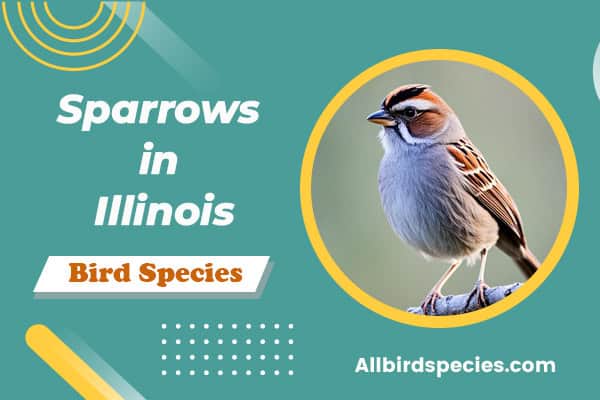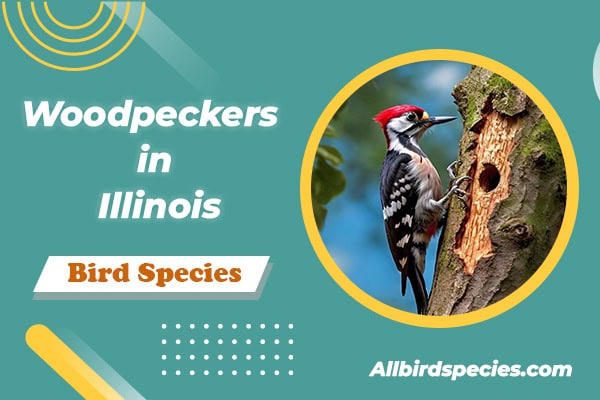Top 9 Sparrows in Illinois You Can Spot (With Pictures)
Did you know Illinois has over 20 types of sparrows? It’s a great place for birdwatchers. The state’s diverse places make it easy to spot different sparrows. You can see everything from the Song Sparrow to the House Sparrow.
These sparrows show how adaptable and strong they are. Each one has its own special traits.
When you explore Illinois, you’ll find many bird species. You’ll learn about their lives, where they live, and why we need to protect them. So, take your binoculars and start your adventure with the sparrows of Illinois!
Understanding Sparrows and Their Habitats
Sparrows are small, interesting birds found in many places across North America. They live in different places, from cities to forests. Knowing how sparrows act can make birdwatching more fun. They live with people and use the natural world well.
The Role of Sparrows in the Ecosystem
Sparrows play a big role in nature. They live in many places and help the ecosystem. They eat insects, which helps protect crops and plants.
They also spread seeds, which helps plants grow and makes nature more diverse. Understanding sparrows helps us see how they keep nature in balance.
Diverse Ecosystems of Illinois
Illinois has many different ecosystems, like vast prairies, wetlands, and dense forests. Each one is vital for the many animals that live here. Sparrows find everything they need in these places to survive and grow.
Prairies are full of tall grasses that sparrows use for shelter and food. Wetlands have lots of water and plants, drawing in sparrows for insects and seeds. Forests give sparrows a safe place to nest and raise their young away from predators.
Even cities add to Illinois’s ecosystem mix. Parks, gardens, and homes can be homes for sparrows that live with people. This shows how sparrows can adapt and live with us.
Knowing about these ecosystems helps birdwatchers find different sparrows at different times. It’s great for spotting various sparrow species in Illinois.
| Ecosystem Type | Key Features | Sparrow Species |
|---|---|---|
| Prairies | Tall grasses, open spaces | Chipping Sparrow, Savannah Sparrow |
| Wetlands | Wet soil, water sources | Swamp Sparrow, Song Sparrow |
| Forests | Dense trees, underbrush | Dark-eyed Junco, White-throated Sparrow |
| Urban Areas | Parks, gardens, residential places | House Sparrow, American Tree Sparrow |
Common Characteristics of Sparrows
Sparrows are interesting birds that share many traits. This makes it easier to spot them for birdwatchers. They have strong bodies for their active lives. Most have a special bill for eating seeds, showing a key sparrow feature.
They often have streaked feathers which helps them hide in different places. This helps them survive better. Watching these sparrow characteristics can teach us about their lives and homes.
Many sparrows eat on the ground in groups. Being together helps them stay safe from predators. Seeing these behaviors helps us know more about sparrows and enjoy Illinois’ nature.
| Sparrow Feature | Description |
|---|---|
| Size | Small, typically 4.5 to 7 inches in length |
| Bill Shape | Conical, well-suited for seed consumption |
| Plumage | Often streaked or mottled, providing camouflage |
| Feeding Habits | Ground feeders, often foraging in flocks |
| Social Behavior | Exhibit social tendencies, commonly seen in groups |
1. Song Sparrow
The Song Sparrow, known as Melospiza melodia, is a beautiful bird. It catches the eye of birdwatchers and nature lovers. Its mottled brown appearance stands out among other sparrows. Learning about its features, feeding, and nesting can make watching these birds more fun.

Identification Features
The Song Sparrow has many striking looks. You can spot it by its:
- Brown crown with a gray stripe
- Distinctive central breast spot
- Gray eyebrow that adds to its unique facial features
- Size ranging from 5.5 to 7 inches in length
- Wingspan of 9.1 to 9.8 inches
These traits make spotting the Song Sparrow fun and rewarding.
Feeding and Nesting Habits
The Song Sparrow changes its diet with the seasons. In summer, they eat insects. In winter, they eat seeds. Watching Song Sparrow feeding in gardens or fields is enjoyable.
They build nests low to the ground, often near water. A nest usually has 3 to 5 eggs. They may raise more than one brood in a season. These habits help them thrive in different places.
2. House Sparrow
The House Sparrow, or Passer domesticus, is a bird that has adapted well to living near humans. It’s interesting to see how it has changed to live in cities. This bird has learned to live close to people, thanks to its special ways of surviving.

Behavioral Adaptations
House Sparrows have traits that help them survive and spread out. They like cities because there’s lots of food and places to nest. They eat seeds, scraps, and bugs, which they find easily in their chosen homes.
- Highly social, they often gather in large flocks.
- They build nests in nooks and crannies, taking advantage of human structures.
- Their vocalizations include chirps and whistles, which facilitate communication within flocks.
Impact on Native Species
House Sparrows have a big effect on local wildlife. As an invasive species in Illinois, they fight hard with native birds for food and homes. This can hurt birds like bluebirds, making it harder for them to find what they need.
This competition with native birds is a worry for those who care about nature. Knowing how House Sparrows behave and affect the environment is key to keeping Illinois’ bird life diverse.
3. Swamp Sparrow
The Swamp Sparrow, or Melospiza georgiana, is a fascinating bird of North America’s wetlands. It lives in certain places and has unique ways of nesting and eating. Learning about these can make you appreciate its role in nature more.

Habitat Preferences
Swamp Sparrows love living in marshy wetlands. They prefer areas with lots of plants for shelter and breeding. The mix of water and plants helps them all year, especially when they’re raising their young.
Nesting and Feeding Behavior
Swamp Sparrows build hidden nests in marsh grass. This keeps their babies safe. In spring, they eat mostly insects. But as winter comes, they eat seeds and plants, showing they can change their diet.
4. Dark-eyed Junco
The Dark-eyed Junco, known as Junco hyemalis, is a common winter bird in Illinois. They are easy to spot and loved by birdwatchers and backyard bird fans. In the cold months, they come to the area in big groups, making them fun to watch.
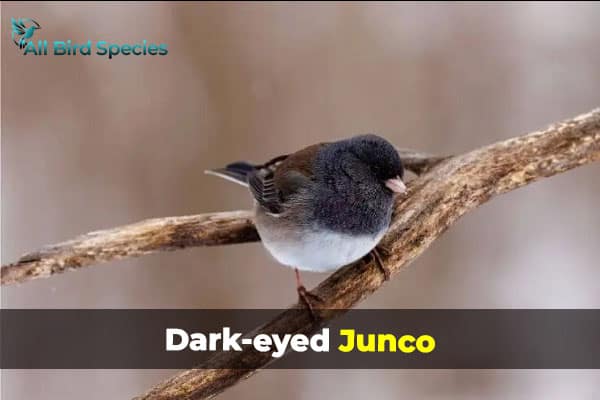
Migration Patterns
Learning about the Dark-eyed Junco migration can make birdwatching better. These birds head south when it gets cold, leaving their homes in the northern U.S. and Canada. They move to places with more food in the winter. You might see them at bird feeders, adding color to your yard.
Physical Description
The Dark-eyed Junco looks striking. They are 5.5 to 6.3 inches long and have gray or brown feathers. Their white belly stands out, helping you tell them apart from other birds. Their bright presence brightens up winter gardens and parks.
Read More Sparrows in Other Regions:
5. White-throated Sparrow
The White-throated Sparrow, known as Zonotrichia albicollis, is a favorite among bird lovers. Its unique songs and calls are easy to recognize. You might hear it say “Oh-sweet-Canada-Canada” in Illinois’ forests during migration.
These bird calls help identify and charm these birds. They make the experience of nature walks more enjoyable.
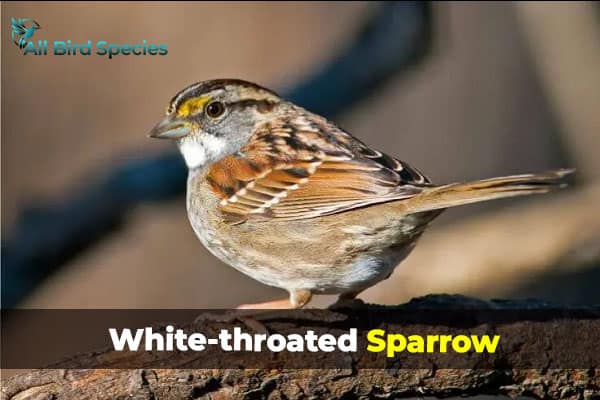
Unique Songs and Calls
The White-throated Sparrow’s songs are unlike any other sparrow. Their whistling adds beauty to nature walks. These songs help them find mates and mark their territory.
Listening to these sounds can make you appreciate these birds more. It helps you understand their nesting habits better.
Nesting Habits
White-throated Sparrows build their nests on or near the forest floor. They use grasses and twigs to make a safe home for their babies. Usually, they lay 3 to 5 eggs, showing their reproductive strategy.
Watching these birds nest can teach us about their survival efforts. It gives us a peek into their world.
6. American Tree Sparrow
The American Tree Sparrow, known as Spizelloides arborea, visits Illinois in the cold months. It stands out with its rusty cap and gray face. These birds live in the Arctic during breeding season and come to Illinois to escape the cold.
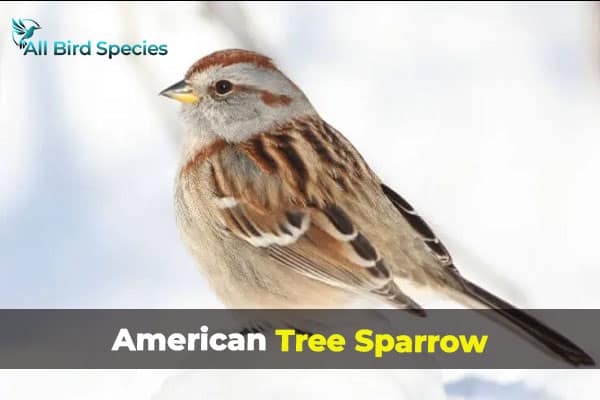
Knowing where they live can make birdwatching more fun.
Geographic Range
In Illinois, you’ll find these sparrows in open woods, shrubs, and fields. They come to these places for food during their migration. Look for them in groups in the winter.
| Characteristics | Details |
|---|---|
| Scientific Name | Spizelloides arborea |
| Breeding Habitat | Arctic areas |
| Winter Habitat in Illinois | Open woodlands, shrubby areas, fields |
| Diet | Seeds, insects |
| Migratory Behavior | Winter visitor to the Midwest |
7. Chipping Sparrow
The Chipping Sparrow, known as Spizella passerina, is common in many Illinois backyards. Birdwatchers love it for its unique sounds. The Chipping Sparrow’s call sounds like “chip-chip-chip”. You can hear these sounds in spring and summer as males claim their territory.
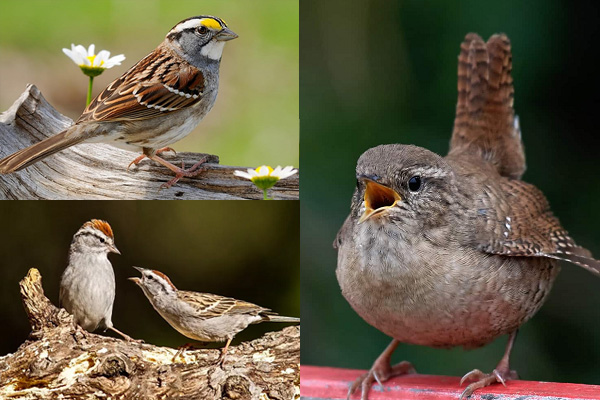
Recognizing Their Calls
Listen for the Chipping Sparrow’s clear, melodic calls. You can hear them in gardens and fields. Their cheerful sounds make days outdoors more enjoyable for nature lovers. Spending time in your garden might mean hearing this lovely bird sing.
Foraging Habits
Chipping Sparrows love to eat seeds, especially different types of grass seeds. They pick these up from the ground. They also eat small insects and invertebrates, especially when they’re breeding.
8. Eastern Towhee
The Eastern Towhee, known as Pipilo erythrophthalmus, is a bird loved by those who watch birds in Illinois. It has striking black and white feathers and a bright rust-colored side. Its call sounds like “drink-your-tea” and can be heard in shrubs and undergrowth.
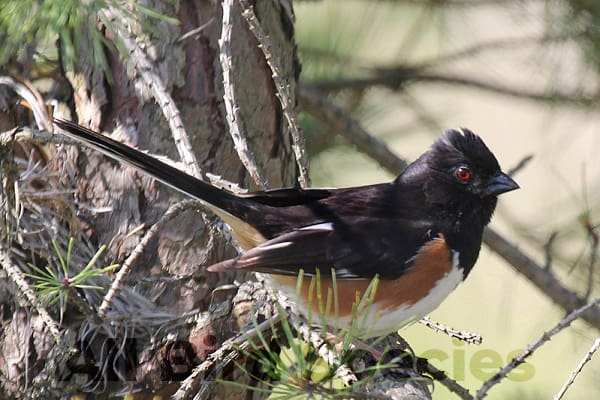
This bird likes living in thick bushes, brushy fields, and woodland edges. Bird watching in Illinois is great for seeing this unique sparrow. It eats seeds, berries, and insects, which it finds in its preferred habitats.
When watching the Eastern Towhee, you’ll see it scratching in the leaves. This shows how it searches for food. This bird makes bird watching more beautiful and helps its environment. So, always have your binoculars ready to see this lovely bird!
9. Savannah Sparrow
The Savannah Sparrow, known as Passerculus sandwichensis, lives in Illinois grasslands. They have unique markings and blend in with dense grasses. Seeing them in the wild is special, especially when you hear their beautiful songs.
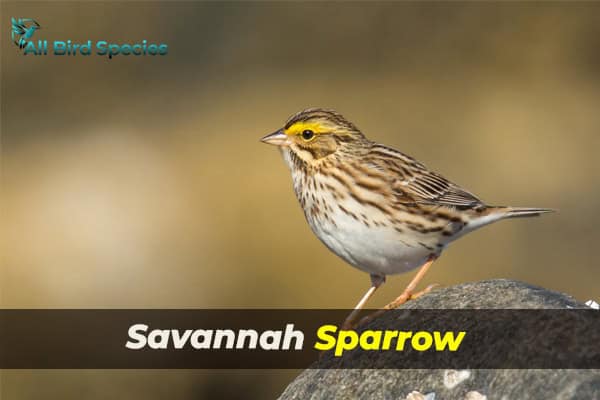
These sparrows don’t usually visit bird feeders. To see them, look in wide, open meadows and grasslands. Birdwatchers love seeing their small movements in tall grass.
The table below shows key facts about the Savannah Sparrow. It will help you spot this bird during your birdwatching trips.
| Attribute | Description |
|---|---|
| Scientific Name | Passerculus sandwichensis |
| Habitat | Illinois grasslands, meadows, and open fields |
| Coloration | Brownish with streaked underparts and a distinctive yellow patch over the eye |
| Song | A series of high-pitched notes that often sound like “savannah, savannah” |
| Behavior | Ground-foraging for seeds and insects |
Knowing about the Savannah Sparrow’s habits helps you spot them in Illinois.
Sparrows in Illinois
Illinois is home to over 20 types of sparrows. These birds make birdwatching in the state exciting. Learning about each Illinois sparrow species can make your birdwatching better. It also helps protect their homes.
Overview of Illinois Sparrow Species
Some sparrows in Illinois are special because of their unique traits and ways of living. Here are a few common ones:
- Song Sparrow
- House Sparrow
- Swamp Sparrow
- Chipping Sparrow
- White-throated Sparrow
These sparrows live in different places, from wetlands to cities. This shows how well they adapt in Illinois. Seeing where they live and how they act helps us protect them.
Importance of Conservation
Keeping sparrows safe is key to Illinois’ nature balance. We need to protect their homes for them to survive. Here’s how we can help:
- Habitat preservation in urban and rural areas
- Restoration of wetlands
- Promoting sustainable land use practices
Helping with sparrow conservation helps keep nature diverse. By protecting their homes, we help these birds for the future. It’s a way to enjoy sparrows and help the environment at the same time.
Check Our Previous Articles:
| Types of Cardinals in North America |
| Herons, Egrets, and Bitterns (Family Ardeidae) |
| Falcons in Massachusetts |
| Types of Cormorants And Shags |
| Types of Cranes |
Conclusion
As you explore the world of birdwatching in Illinois, you’ll find the sparrows add magic to your journey. This guide has shown you the different types of sparrows, their special features, and where they live. It’s key to know about these birds for fun and to help them survive.
Every sparrow has its own story and plays a big part in nature. By loving these birds and their homes, you help protect them. This way, future generations can also enjoy nature and the many birds Illinois has.
Use this guide on your birdwatching trips. And always enjoy watching these lovely birds!

